火縄銃に「小栗又一 忠高造」の銘 Matchlock inscribed "Made by Tadataka Mataichi Oguri" |
|||
.jpg) |
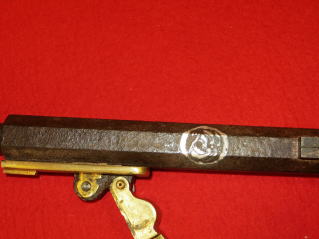 |
||
| ▲銃身を外した 銃把が田付流を示している By removing the barrel, you can see that the grip shows the Tatsuke style. |
▲家紋「丸に立浪」 銘はこの真裏にあった The family crest of Oguri, "Maru-ni Tachinami: The inscription was located directly behind the family crest. |
||
| 東善寺の小栗上野介遺品館に展示している遺品は2700石の旗本にしては数量が少ない、と言われることがある。 ご存知のとおり、小栗上野介父子が西軍に殺された。そのあと江戸から東善寺に運ばれていたたくさんの家財道具は全て西軍が没収して高崎に運び、飛脚問屋嶋屋で入札によって売却してしまった。殺された後も舟で倉賀野河岸まで届いたたくさんの家財は、受取人がいないためセリ売りに掛けられ、ほとんどが散逸してしまった。新政府軍が行なった強盗殺人といえる。 いま展示している品は寺に伝わったもの数点のほかは村人が「お殿様から頂いたもので」と大事にしてきた品を寄贈あるいは寄託されたもの。この火縄銃は原田實氏の昭和30年代の寄贈品。 そのうち、火縄銃を手入れに出したところ、鉄の銃身の裏側(家紋の真裏でふだんは木部に隠れて見えない部分)に次の銘が見つかった。 「小栗又一 忠高造」 ※「又一」は小栗家四代忠政以来、代々襲名した名前。十二代忠順も「又一」だった。 Some visitors to Tozenji Temple say that the relics on display at the Kozukenosuke Oguri Relics Museum at the temple are small in number for a bannerman of 2,700 koku. As is well known, Kozukenosuke Oguri and his son were killed by the Western Army. After they were killed, all the many household goods that had been brought from Edo to Tozenji were confiscated by the West and taken to Takasaki, where they were sold by bidding at Shimaya, an express delivery agent. Even after Oguri was killed, many of the household goods that had been delivered by boat to the Kurgano riverbank were sold at an auction and most of them were scattered because there were no recipients. It was a robbery and murder committed by the new government forces. The items on display at the Museam include several items that have been handed down to the temple, as well as items donated or entrusted to the temple by villagers who treasured them, saying that they were given to them by the lord Oguri. This matchlock was donated to Tozenji Temple by Minoru Harada in the 1950s. When the matchlock was sent for maintenance service, the following inscription was found on the underside of the iron barrel (directly behind the family crest, usually hidden on the wood). "Made by Tadataka Mataichi Oguri" * The name "Mataichi" has been passed down from generation to generation since the fourth generation of the Oguri family, Tadamasa. The 12th Tadamasa was also named "Mataichi." (It may be confusing, but "Tadamasa" of 4th generation and "Tadamasa" of 12th generation are written in different Kanji charactors.) |
|||
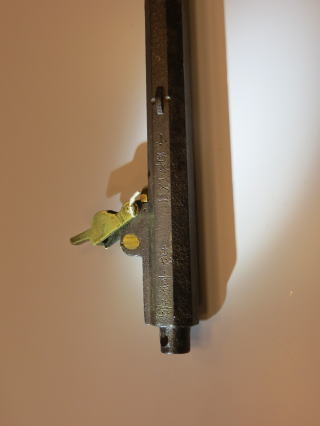 |
|||
この銘のある場所は刀の柄にあたるところで、ふつう鉄砲鍛冶の銘が入るところ、銘がない場合「無銘」となる。 手入れを仲介した発見者峯田元治氏(日本銃砲史学会)によれば、旗本が自ら銃を鍛えることは珍しく、これまでこういう例は見たことがない、とのこと。 The place where this inscription is placed is equivalent to the handle of a sword, and is usually where the gunsmith's inscription is placed. If there is no inscription, it is called "unmarked." According to the discoverer of the inscription, Mr. Motoharu Mineta (of Firearms Historical Academy of Japan), who arranged the maintenance care, it is rare for a Hatamoto to forge firearms himself, and he has never seen such a case before. |
|||
| 小栗忠高は ・小栗家11代忠高は江戸駿河台の旗本中川飛騨守忠英(ただてる)の四男。初名は堅固。文化六年(1809)一月三日生まれ ・文化十年(1813・五歳)七月、小栗忠清が病気となったので、家名断絶を防ぐため小栗家に五歳で養子として入り、忠清の娘クニ(邦子)の婿となる。 ・同年七月二十八日、忠清は二十二歳で病死。 ・文政九年(1826・十八歳)御小姓組に御番入り、天保十三年(1842)三月将軍家慶の白書院広縁での剣術御覧に上覧を得る。四月、乗馬を上覧。 ・弘化四年(1847・三十九歳)十月、持筒頭。 ※銃を鍛えていたのはこの前後ではあるまいか(忠順はこの年二十一歳) ・嘉永四年(1854・四十六歳)九月、新潟奉行として赴任。 ・翌安政二年(1856・四十七歳)七月、新潟において四十七歳で病没。新潟市法音寺に葬る。 ・長男 忠順ひとり 長女貞子は忠順が八歳のときに早世。 Tadataka Oguri - Tadataka, the 11th generation of the Oguri family, was the fourth son of Hidanokami Tadateru Nakagawa, a Hatamoto residing at Surugadai, Edo. His first name was Kengo. Born on January 3, 1809 (3rd year of Bunka). - In July 1813 (10th year of Bunka), when Tadakiyo Oguri became ill, Tadataka was adopted into the Oguri family at the age of 5 to prevent the family name from being cut off, and later married to Kuniko, Tadakiyo's daughter. - On July 28 of the same year, Tadakiyo died of illness at the age of 22. - In 1826 (9th year of Bunsei), he joined a group of koshos (young people who do miscellaneous work for the shogun or feudal lord) at the age of 18. - In March 1842, he was given the honor of being invited to the Shogun Ieyoshi's observation of swordsmanship exhibition at the Shiroshoin (a large hall in the Shogunate's imperial palace). In April of the same yeara, he was allowed to observe horse riding. - In October of 1847 (age 39), he became the Mochizutsu-Gashira (a person in the Edo Shogunate, who was in charge of the Shogun's guns and led dozens of men to guard the Shogun in times of war and fortified the inner gate of the Edo Castle's Honmaru in times of peace). * It was probably around this time that he was training to make firearms (Tadataka's son, Tadamasa, was 21 years old in this year). - In September 1854 when he was 46 years old, he was transferred to Niigata as a magistrate. - In July 1846, he died of illness in Niigata at the age of 47. He was buried at Houonji Temple in Niigata City. - Tadataka had a son, Tadamasa, and a daughter, Sadako, but Sadako died when Tadamasa was 8 years old. |
|||
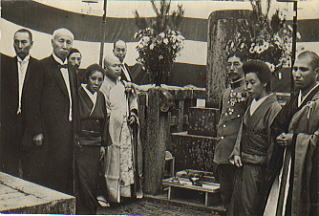 |
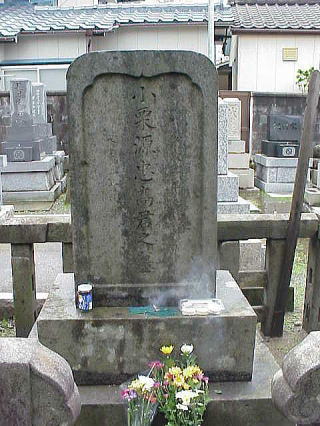 |
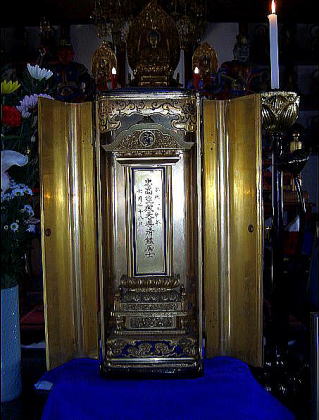 |
|
| ▲大正4年月忠高の墓参をする大隈重信・綾子夫妻 ▲ Shigenobu Okuma and his wife, Ayako, visited the grave of Tadataka in 1915. |
▲小栗忠高の墓 ・ 新潟市法音寺 (墓碑裏の碑文は東善寺に拓本の掛軸がある) ▲ Tomb of Tadataka Oguri at Houonji Temple, Niigata City (Rubbed copy of the inscription on the back of the tombstone is kept at Tozenji Temple.) |
▲小栗忠高の位牌 忠高院殿天眞清鑑居士 ・新潟市法音寺 ▲ Tadataka Oguri's tablet at Houonji Temple, Niigata City |
|
| 銃の銘「忠高造」の意味 ・旗本が自ら銃身を鍛えていたことは珍しい。 ・息子忠順も砲の研究を熱心にしていたと伝わる。 ・探究心が強く、つねに現場をきちんと抑えるリアリスト忠順の性格に、父忠高の性格が強く影響していると思われる。 The inscription on the matchlock, "Made by Tadataka Mataichi Oguri," means: - It is rare that a Hatamoto forged the barrel of a firearm by himself. - It is said that his son, Tadamasa, was also a keen researcher of firearms. - Tadamasa was an inquisitive mind and a realist who always keeps the field in check, and his character seems to have been strongly influenced by his father Tadataka's character. |
|||
 |
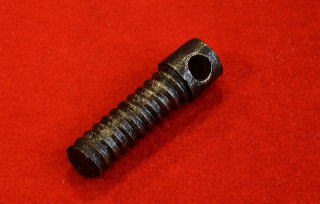 |
||
| ▲尾栓ネジ 鉄砲が種子島伝来して以来、鉄砲鍛冶は尾栓ネジを一本ずつヤスリを掛け手作りしてきた。雌ねじの多くは雄ネジを入れた銃身を熱して叩き、雄ネジのネジ山に合うよう整える「熱間鍛造法」で作ったという。一本ずつ造るから、「ネジみたいなもの」と言えようが、よく作ったものだ。丸い穴は銃身掃除のとき棒を挿してT字型にして回すため。 ▲ Since the introduction of firearms to Tanegashima, gunsmiths in Japan have been making tailstock screws by hand, one by one, using a file. Most of the female screws were made by the "hot forging method," in which a gun barrel with a male screw in it was heated and beaten to fit the threads of the male screw. Since they are made one by one, you could say they are "like screws," but it is amazing that they were able to make such things. The round hole is for inserting a rod and turning it in a T-shape when cleaning the barrel. |
|||